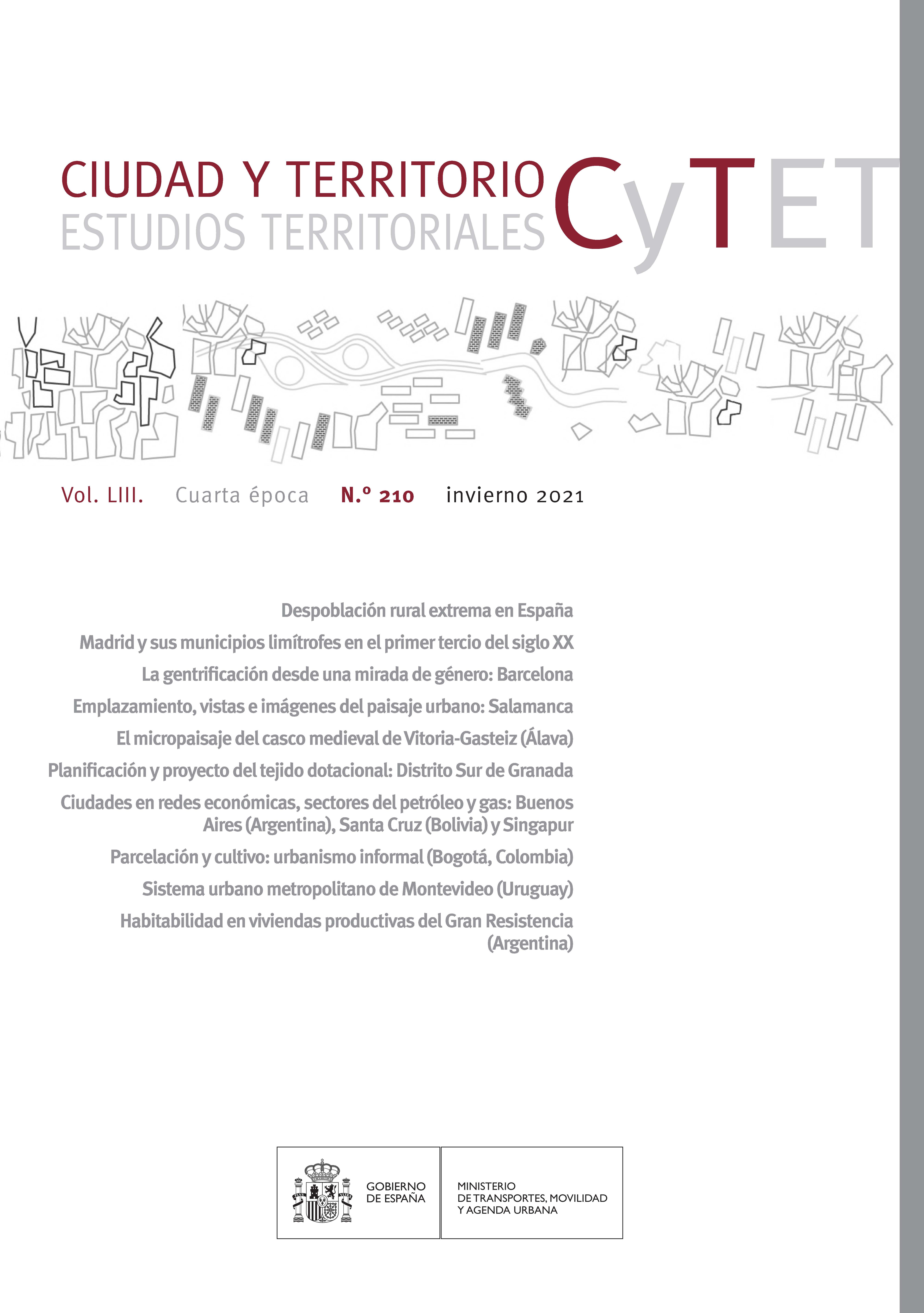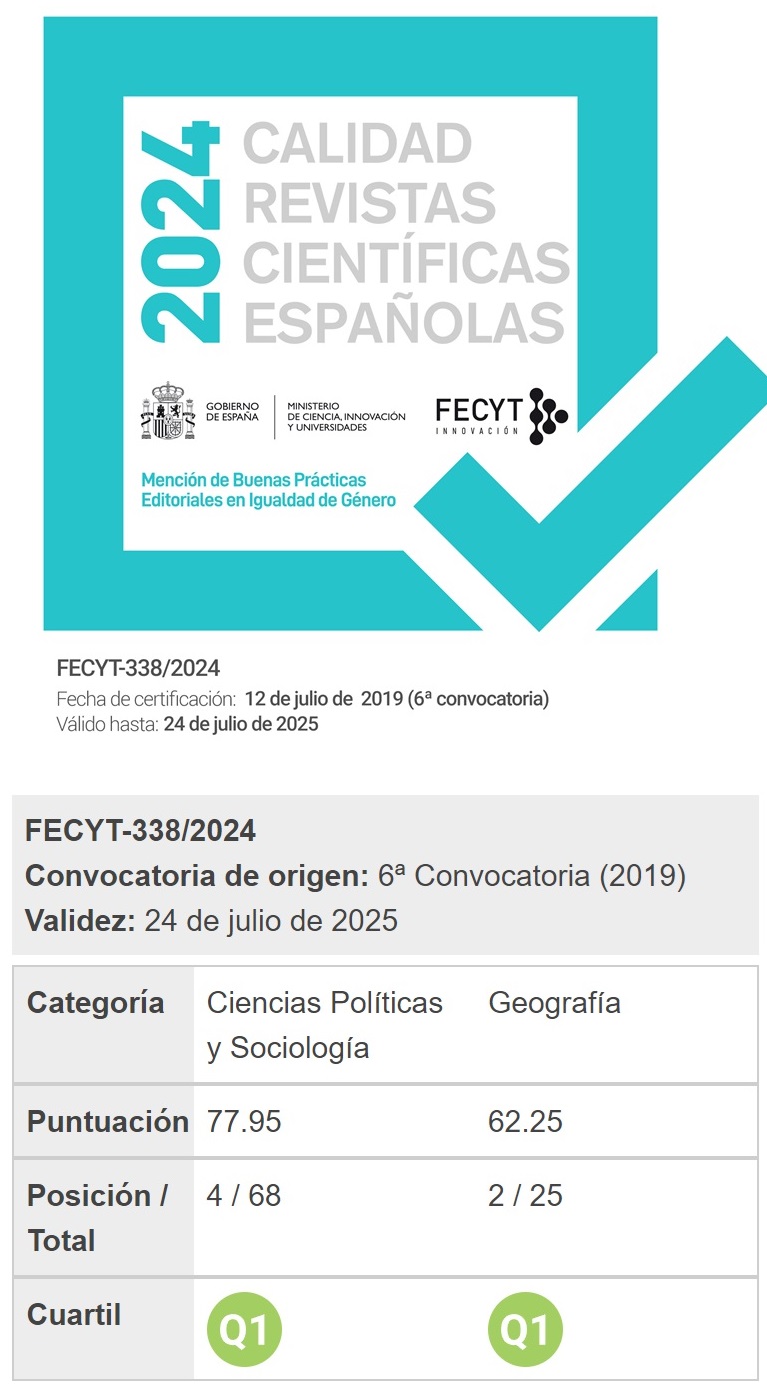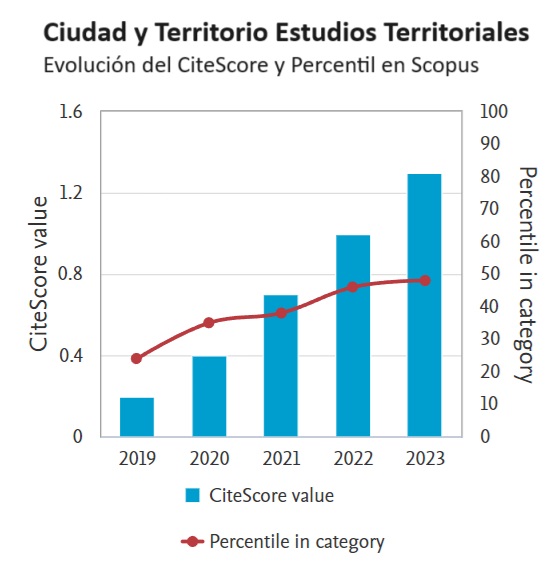Planificación y proyecto para el fortalecimiento del tejido dotacional: el Distrito Sur de Granada
DOI:
https://doi.org/10.37230/CyTET.2021.210.06Palabras clave:
Equipamiento, Espacio público, Planificación urbana, Proyecto urbano, Estructura urbanaResumen
En el contexto actual, la producción urbana de lo público es clave para la cohesión espacial y social. Desde la planificación y el proyecto urbano son necesarios criterios y herramientas para la mejor conformación del tejido dotacional en la ciudad, valorando sus cualidades, requerimientos y responsabilidades locales. Partiendo de las múltiples dimensiones de los equipamientos y espacios públicos, se analiza su consolidación en el Distrito Sur de Granada mediante la interpretación de sus planeamientos generales y la observación comparativa de la implementación de dos polideportivos. Se pone de manifiesto la necesidad de atender al proyecto del espacio adjunto al equipamiento, a sus relaciones urbanas de proximidad entre las esferas pública y privada, y de velar por un urbanismo que posibilite la apropiación e integre el equipamiento y su espacio asociado en el tejido barrial.
Descargas
Citas
Banzhaf, H. S. & Farooque, O. (2013): Interjurisdictional housing prices and spatial amenities: Which measures of housing prices reflect local public goods? Regional Science and Urban Economics, 43: 635–648. https://doi.org/10.1016/j.regsciurbeco.2013.03.006
Borja, J. & Castells, M. (1998): Local y global. Barcelona, España: Taurus Editores.
Borja, J. & Castells, M. & Muxi, Z. (2003): El espacio público: ciudad y ciudadanía. Barcelona, España: Diputación de Barcelona y Electa.
Bravo, B. (2018): La ciudad doméstica. La construcción de la primera periferia al sur de Granada. Tesis Doctoral, Universidad de Granada. Disponible en: http://hdl.handle.net/10481/50142
Breitung W. (2011): Borders and the city: Intra-urban boundaries in Guangzhou (China). Quaestiones Geographicae, 30(4), pp. 55–61. Poznań, Polonia: Bogucki Wydawnictwo Naukowe. https://doi.org/10.2478/v10117-011-0038-5
Bresciani, L. E. (2010): Chile 27F 2010: La catástrofe de la falta de planificación. EURE, 36(108): 151-153. http://dx.doi.org/10.4067/S0250-71612010000200007
Burriel, E. L. (2008): La “década prodigiosa” del urbanismo español (1997-2006). Scripta Nova, vol. XII, núm. 270 (64). http://www.ub.edu/geocrit/-xcol/383.htm
Calderón, B. & García, J. L. (2017): Legislación urbanística y planeamiento urbano en España, 1998-2015. Scripta Nova, vol. XXI. núm. 570. https://doi.org/10.1344/sn2017.21.19429
Canto C. M. (2008): Gobernanza y participación ciudadana en las políticas públicas frente al reto del desarrollo. Revista Política y Cultura, 30: 9-37.http://www.redalyc.org/articulo.oa?id=26711160002
Castro-Coma, M. & Martí-Costa, M. (2016): Comunes urbanos: de la gestión colectiva al derecho a la ciudad. EURE, 42(125): 131-153.http://dx.doi.org/10.4067/S0250-71612016000100006
Chang, H. S. & Liao, C. H. (2011): Exploring an integrated method for measuring the relative spatial equity in public facilities in the context of urban parks. Cities, 28(5): 361–371.https://doi.org/10.1016/j.cities.2011.04.002
De Certeau, M. (2000): La invención de lo cotidiano. México, México: Universidad Iberoamericana
Fernández, G. R. (2015): Urbanismo y corrupción. Etiología de una práctica ilícita. Encuentros multidisciplinares, 17(50): 14-22. https://dialnet.unirioja.es/servlet/articulo?codigo=5407319
Galarraga, A. & Luna, Á. & González, S. (2013): Cultura y creatividad en la nueva economía urbana. Revista de Dirección y Administración de Empresas, 20: 33-55. https://cercles.diba.cat/documentsdigitals/pdf/E140040.pdf
Garriz, E. J. & Schroder, R. V. (2014): Dimensiones del espacio público y su importancia en el ámbito urbano. Revista Científica Guillermo de Ockham, 12(2): 25-30. https://doi.org/10.21500/22563202.59
Gehl, J. (2011): Life Between Buildings: Using Public Space. London: Island Press.
Gigosos, P. & Saravia, M. (1993): Relectura del planeamiento español de los años 80: generación de planes, generaciones de urbanistas. Ciudades, 1: 37-52. https://doi.org/10.24197/ciudades.01.1993.37-52
Hanyu, K. (1997): Visual properties and affective appraisals in residential areas after dark. Journal of Environmental Psychology, 17(4): 301–315. https://doi.org/10.1006/jevp.1997.0067
Harvey, D. (2008): El derecho a la ciudad. New Left Review, 53: 23-39. https://newleftreview.es/issues/53/articles/david-harvey-el-derecho-a-la-ciudad.pdf
Hernández, A. (director) (1997): La ciudad de los ciudadanos. Madrid, España: Ministerio de Fomento.
Instituto Nacional de Estadística (2017). Datos estadísticos. https://www.ine.es/
Isac, Á. (1987): Transformación urbana y renovación arquitectónica en Granada. Del "plano geométrico" (1846) al gran parque (1929). Cuadernos de arte de la Universidad de Granada, 18: 207-230. https://core.ac.uk/download/pdf/230513481.pdf
Kaiser, E. J. & Godschalk, D. R. & Chapin, F. S. (1995): Urban land use planning (4th ed.). Chicago, Estados Unidos: Urbana and University of Illinois.
Kapstein, G. & de La Barra, X. (1979): El equipamiento como instrumento de transformación social. Ciudad y Territorio. Estudios Territoriales (CyTET), 40: 29-38. https://recyt.fecyt.es/index.php/CyTET/article/view/81234
Leal, J. (1979): Fundamentos para un análisis de los equipamientos. Ciudad y Territorio. Estudios Territoriales (CyTET), 40: 9-14. https://recyt.fecyt.es/index.php/CyTET/article/view/81232
Lefebvre, H. (1975b): El derecho a la ciudad. Barcelona, España: Península.
Lefebvre, H. 2013): La producción del espacio. (E. Martínez, Trad.). Madrid, España: Capitán Swing.
Ledrut, R. (1976): Sociología urbana. Madrid, España: Instituto de Estudios de Administración Local.
Li, H. & Wei, Y. H. D. & Yu, Z. & Tian, G. (2016): Amenity, accessibility and housing values in metropolitan USA: a study of Salt Lake County, Utah. Cities, 59: 113-125. https://doi.org/10.1016/j.cities.2016.07.001
Low, S. & Altman, I. (1992): Place attachment: a conceptual inquiry. En I. Altman & S. M. Low (eds.), Place Attachment (pp. 1-12). New York, Estados Unidos: Plenum Press.
Martínez, E. (2014): Configuración urbana, hábitat y apropiación del espacio. Scripta Nova, 18(493).https://revistes.ub.edu/index.php/ScriptaNova/article/view/15022
Ministerio de Medio Ambiente (2007): Libro verde del medio ambiente urbano. Madrid, España: Centro de publicaciones, Ministerio de Medio Ambiente.
Mitchell, D. (2003): The right to the city. Social justice and the fight for public space. New York, Estados Unidos: The Guilford Press.
Moreno, J. L. (2006): Dotaciones, equipamientos urbanísticos: el sustrato de la urbanística social. Madrid, España: Editorial Montecorvo.
Moroni, S. & Chiodelli, F. (2014): Public Spaces, Private Spaces, and the Right to the City. International Journal of E-Planning Research, 3(1): 51-65. https://doi.org/10.4018/ijepr.2014010105
Mouratidis, K. & Hassan, R. (2020): Contemporary versus traditional styles in architecture and public space: A virtual reality study with 360-degree videos. Cities, 97. https://doi.org/10.1016/j.cities.2019.102499
Nasar, J. L. (1994): Urban design aesthetics: The evaluative qualities of building exteriors. Environment and Behavior, 26(3): 377–401. https://doi.org/10.1177/001391659402600305
Newman, M. E. J. (2003): The Structure and Function of Complex Networks. SIAM REVIEW, 45(2): 167-256. https://doi.org/10.1137/S003614450342480
Olvera, A. J. (2003): Sociedad Civil, Gobernabilidad Democrática, Espacios Públicos y Democratización: Los Contornos De Un Proyecto. San José, Costa Rica: Cuadernos de la Sociedad Civil. Costa Rica, Instituto de Comunicación y Desarrollo. http://www.lasociedadcivil.org/wp-content/uploads/2014/11/olvera_copy.pdf
Omer, I. (2006): Evaluating accessibility using house-level data: A spatial equity perspective. Computers, Environment and Urban Systems, 30: 254–274.
Peña, F. (1986): El Plan General de Granada. Tratamiento de las márgenes del río Genil y vía perimetral. Geometría, nº 2: 24-37.
Portas, N. (2003): El surgimiento del proyecto urbano. Perspectivas Urbanas, (3).https://upcommons.upc.edu/handle/2099/555
Portas, N. & Domingues, Á. & Cabral, J. (2007): Políticas Urbanas. Tendencias, estrategias y oportunidades. Lisboa, Portugal: Fundación Galouste Gulbenkian.
Peimbert, A. (2019): Tensiones sincopadas y narrativas paradójicas sobre el espacio público en una ciudad fronteriza. EURE, 45(136): 255-276. http://dx.doi.org/10.4067/S0250-71612019000300255
Rapoport, A. (2013): History and precedent in environmental design. Londres, Inglaterra: Springer Science & Business Media.
Reig, E. & Goerlich, F. J. & Cantarino, I. (2016): Delimitación de áreas rurales y urbanas a nivel local. Demografía, coberturas de suelo y accesibilidad. Informes 2016. Economía y Sociedad. Madrid, España: Fundación BBVA. https://www.fbbva.es/wp-ontent/uploads/2017/07/FBBVA_Esenciales_6_tcm269-587558.pdf
Rivas, J.L. (2015): Un urbanismo de la observación: Metodologías prospectivas en torno a la idea de calle ciudad en tres capitales andaluzas (Córdoba, Málaga y Granada). EURE, 41(123): 131-158.http://dx.doi.org/10.4067/S0250-71612015000300006
Rivas, J. L., & Bravo, B. (2017): Aproximación a la primera periferia al sur de Granada: de las huertas a las villas urbanas (1920-1951). Ciudades, 19: 163-187. https://doi.org/10.24197/ciudades.19.2016.163-187
Román, A. (2014): La gestión indirecta de los servicios públicos. Algunos mecanismos de racionalización y control. Administración de Andalucía: Revista andaluza de administración pública, 89: 111-154.:http://hdl.handle.net/11441/63756
Rosen, S. (1974): Hedonic prices and implicit markets: Product differentiation in pure competition. Journal of Political Economy, 82: 34–55.http://dx.doi.org/10.1086/260169
Sassen, S. (2003): Localizando ciudades en circuitos globales. EURE, 29(88): 5-27.http://dx.doi.org/10.4067/S0250-71612003008800001
Schindler, I. & al. (2017): Measuring aesthetic emotions: A review of the literature and a new assessment tool. PloS One, 12(6).https://doi.org/10.1371/journal.pone.0178899
Secchi, B. (2006): Land Design 2. En A. Aymonino & V. P. Mosco, Contemporary public space: un-volumetric architecture (pp. 287-291). Milán, Italia: Skira.
Secchi, B. (2007): Urban scenarios and policies. En N. Portas, Á. Domingues, & J. Cabral (eds.), Políticas Urbanas. Tendencias, estrategias y oportunidades (pp. 274-283). Lisboa, Portugal: Fundación Calouste Gulbenkian.
Seixas J. (2014): La ciudad en la encrucijada: repensar la ciudad y su política. Valencia, España: Tirant Humanidades.
Sheppard, S. (1999): Hedonic analysis of housing markets. En P. Cheshire, & E. S. Mills (vol. eds.), Handbook of regional and urban economics. Vol. 3. Handbook of regional and urban economics (pp. 1595–1635). Amsterdam, Holanda: Elsevier. https://doi.org/10.1016/S1574-0080(99)80010-8
Solà-Morales, M. & Parcerisa, J. (1987): El urbanismo urbano. Forma urbana y planeamiento urbanístico en siete capitales españolas. Estudios Territoriales, 24: 33-51.
Solà-Morales, M. (1992): Espacios públicos y espacios colectivos. Un nuevo reto: urbanizar lo privado. La Vanguardia (12/05/1992).
Taylor, S. J. & Bodgan, R. (1987): Introducción a los métodos cualitativos de investigación. Barcelona: Paidós.
Taleai, M. & Sliuzas, R. & Flacke J. (2014): An integrated framework to evaluate the equity of urban public facilities using spatial multi-criteria analysis. Cities, 40: 56–69.https://doi.org/10.1016/j.cities.2014.04.006
Tassin, E. (1999): Identidad, ciudadanía y comunidad política: ¿qué es un sujeto político? En H. Quiroga & al. (comps.). Filosofías de la ciudadanía: sujeto político y democracia (pp. 49-68). Rosario, Argentina: Homo Sapiens Ediciones.
Teitz, M.B. (1968): Toward a theory of public facility location. Papers of the Regional Science Association, 21: 35-51.https://doi.org/10.1111/j.1435-5597.1968.tb01439.x
Terán, F. de (1978): Planeamiento urbano en la España contemporánea: historia de un proceso imposible. Gustavo Gili.
Tse, R. Y. C. (2002): Estimating neighbourhood effects in house prices: Towards a new hedonic model approach. Urban Studies, (39): 1165–1180. http://dx.doi.org/10.1080/00420980220135545
Tsou, K. W. & Hung, Y. T. & Chang, Y. L. (2005): An accessibility-based integrated measure of relative spatial equity in urban public facilities. Cities, 22(6): 424-435. https://doi.org/10.1016/j.cities.2005.07.004
Varela B. E. (2015): Nuevos roles de los gobiernos locales en la implementación de políticas públicas. Gobernabilidad territorial y competitividad global. EURE, 41(123): 213-237. http://dx.doi.org/10.4067/S0250-71612015000300009
Viegas, J. M. (2007): Estrategias Urbanísticas e Governabilidade. En N. Portas & Á. Domingues & J. Cabral (eds.), Políticas Urbanas. Tendencias, estrategias y oportunidades (pp. 261-273). Lisboa: Fundación Galouste Gulbenkian.
Publicado
Cómo citar
Número
Sección
Licencia
Derechos de autor 2021 Belén Bravo Rodríguez, Juan Luis Rivas Navarro

Esta obra está bajo una licencia internacional Creative Commons Atribución-NoComercial-SinDerivadas 4.0.
Sin perjuicio de lo dispuesto en la legislación vigente sobre Propiedad Intelectual, y conforme a la misma, el/la los/las autor/a/es/as que publiquen en CyTET cede/n a título gratuito, de modo no exclusivo y sin límite temporal al Ministerio de Transportes, Movilidad y Agenda Urbana los derechos para difundir, reproducir, comunicar y distribuir en cualquier formato actual o futuro, en papel o electrónico, la versión original o derivada de su obra bajo licencia de Creative Commons Reconocimiento-NoComercial-SinObraDerivada 4.0 Internacional (CC BY-NC-ND 4.0), así como para incluir o ceder a terceros la inclusión de su contenido en índices, repositorios y bases de datos nacionales e internacionales, con referencia y reconocimiento en todo caso de la autoría del mismo.
Además, al realizar el envío, el/la los/las autor/a/es/as declara/n que se trata de un trabajo original en el que se reconocen las fuentes que han sido utilizadas en su estudio, comprometiéndose a respetar la evidencia científica y a no modificar los datos originales para verificar o refutar una hipótesis de partida; que el contenido esencial del mismo no ha sido publicado previamente ni se publicará en ninguna otra obra o revista mientras esté en proceso de evaluación en la revista CyTET; y que no se ha remitido simultáneamente a otra publicación.
Los autores deben firmar un Formulario de Cesión de Derechos, que les será enviado desde la Secretaría de CyTET una vez se acepte su artículo para ser publicado.
Con el objetivo de favorecer la difusión del conocimiento, CyTET se adhiere al movimiento de revistas de Open Access (OA) y entrega la totalidad de sus contenidos a diversos índices, repositorios y bases de datos nacionales e internacionales bajo este protocolo; por tanto, la remisión de un trabajo para ser publicado en la revista presupone la aceptación explícita por parte del autor/a de este método de distribución.
Se anima a las/os autoras/es a reproducir y alojar sus trabajos publicados en CyTET en repositorios institucionales, páginas web, etc. con la intención de contribuir a la mejora de la transferencia del conocimiento y de la citación de dichos trabajos.








 Enlace a CyTET en Linkedin
Enlace a CyTET en Linkedin